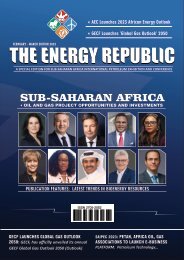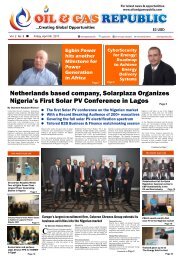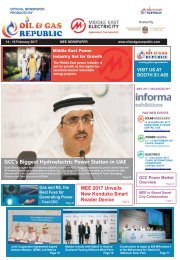The Energy Republic July Edition 2022
This magazine is a Special Edition focused on the NOG Conference and Exhibition 2022. The Nigeria oil and gas industry is undergoing a transformation following the recent policy enactment such as the Petroleum Industry Act (PIA) and ‘Decade of Gas Initiatives’ led by the Federal Government of Nigeria. This years’ NOG Conference features world-class conference programmes, including panel sessions to enable industry stakeholders, players and government discuss strategies in funding Nigerian energy mix going forward. In this edition, we featured an exclusive interview with H.E Chief Timipre Slyva, Honourable Minister of State for Petroleum Resources, including stakeholders and experts commentaries which are aligned based on the global trends in the energy, oil and gas industry. For general inquiries, please email us at: info@theenergyrepublic.com
This magazine is a Special Edition focused on the NOG Conference and Exhibition 2022. The Nigeria oil and gas industry is undergoing a transformation following the recent policy enactment such as the Petroleum Industry Act (PIA) and ‘Decade of Gas Initiatives’ led by the Federal Government of Nigeria. This years’ NOG Conference features world-class conference programmes, including panel sessions to enable industry stakeholders, players and government discuss strategies in funding Nigerian energy mix going forward.
In this edition, we featured an exclusive interview with H.E Chief Timipre Slyva, Honourable Minister of State for Petroleum Resources, including stakeholders and experts commentaries which are aligned based on the global trends in the energy, oil and gas industry.
For general inquiries, please email us at: info@theenergyrepublic.com
You also want an ePaper? Increase the reach of your titles
YUMPU automatically turns print PDFs into web optimized ePapers that Google loves.
SPECIAL REPORT
engine. Another advantage of
hydrogen is that it can be easily
transported and injected in the existing
gas infrastructure with manageable
changes. For this reason, in areas where
electricity cannot be adequately
generated from renewable sources,
hydrogen can be beneficial. Therefore,
hydrogen is the perfect energy storing
compound, yet missing to shift entirely
to renewable energy sources.
Research has shown that the demand
for hydrogen will soon significantly
exceed the volume that can be locally
produced in Germany and that,
according to the Max Planck Institute
for Chemical Energy Conversion, it will
need to import at least five million tons
of hydrogen in 2025, 23 million in 2040
and 45 million in 2050.
Within the European Union, the annual
demand for hydrogen will increase
sevenfold from approximately 325
terawatt hours ("Twh") in 2015 to 2,250
TWh in 2050.
This increased hydrogen demand will
stem from new uses in the power,
transportation, industry (heat and
feedstock), and building sectors.
When considering locations offering a
high renewable energy potential that
can be used for the transformation into
green hydrogen at low cost, Africa
places itself in the middle of attention.
Within the scope of the so-called Atlas
of Green Hydrogen Generation
Potentials in Africa ("H2Atlas"), a
multilateral cooperation between
Germany and West and sub-Saharan
African states (ECOWAS and SADC) has
been developed to evaluate the
potential to generate green and
climate-neutral energy in Africa using a
joint venture between German
expertise and African natural settings.
The German Federal Research Minister
Anja Karliczek has been quoted as
saying that the Federal Research
Ministry will provide up to EUR 40
million in funding from the economic
stimulus package for cooperation
within the framework of this
partnership. It is calculated that
hydrogen production in West Africa is at
least twice cheaper than in Germany
and West Africa is said to have the
potential to generate approximately
165,000 terawatt hours of green hydrogen
per year.
C a s e - st u d y : G e r m a n - M o ro c can
Partnership
Morocco specifically offers potential for
foreign investors due to its significant
experience with large renewable energy
projects like, to name just one, the Noor
Power Station – a solar power plant with a
capacity of 580 MW and one of the largest
and most modern solar power facilities in
the world. Germany invested substantially
both economically and by German
companies contributing to the construction
of the complex. In addition, Morocco is
naturally ideally situated for the production
of green hydrogen, its by-products and for
the export of the same.
It was therefore not overly surprising that
Morocco was chosen as the first to benefit
from the international partnership
component of the German National
Hydrogen Strategy, a country whose
political agenda ranks hydrogen production
very highly, even having its own Hydrogen
Roadmap. The German-Moroccan energy
partnership has already realized many
renewable energy projects and will do so for
hydrogen production in the future. Morocco
is, after South Africa, one of the African
countries with the highest annual
investment figures from Germany.
With its partnership with Morocco, German
plans to import not only hydrogen but also
its reaction products which will aid the
reduction of fossil fuel usage in Germany
and assist Germany in achieving its own
climate objectives. The respective seaports
of Tangiers and Hamburg will play a role in
the transport of the hydrogen produced in
Morocco back to Germany and they agreed
to strengthen their cooperation in October
2020.
The German Morocco Green Hydrogen
Cooperation Agreement was signed in June
2020 in Germany’s capital Berlin, between
the Moroccan Ambassador to Germany,
Zohour Alaoui, and the German Federal
Minister for Economic Cooperation and
Development, Gerd Müller.
The partnership aims at the production of
green hydrogen by developing the African
continent’s first industrial green hydrogen
production plant (estimated German
funding of over approximately EUR
300,000,000) and at the implementation of
research and investment projects on the use
of this clean energy source. The agreement
was part of the long-standing energy
cooperation between Germany and
Morocco. It is planned to build an initial
project with a 100 MW electrolysis capacity
to transform electric energy into hydrogen.
Outlook
Other African countries of interest
particular to Germany include Namibia
where there is huge potential for the green
hydrogen industry not least of all because of
its high winds and some 3,500 hours of
sunshine per year. In Namibia the eventual
cost of green hydrogen is estimated to
become the most competitive in the world.
In August 2021, Namibia and Germany
joined forces in green hydrogen
development. Namibia has the natural
resources, while Germany wants to become
a world-leading hydrogen economy. A new
partnership will see Germany inject €40M
with the aim of putting both countries at the
forefront of clean energy innovation. The
deal will see Germany offer Namibia a
helping hand plus €40 million to boost its
green hydrogen production, in return for a
future cheap supply of the gas.
Namibia is home to 2.5 million inhabitants.
It has massive wind power potential and
twice the solar power yield of Germany,
according to Marius Holst, research
associate at the Fraunhofer Institute for
Solar Energy Systems.
This makes the south west African country a
potential hotspot for cheap clean hydrogen
production. The cost of a kilogramme of
clean hydrogen produced in the country is
projected to be somewhere between €1.50
and €2.00, with exports foreseen to start
before 2025. For Namibia, the new
partnership means investment, jobs and
potential leadership in the future market.
With the EU and other regions around the
world like California (USA), Canada and
Japan already having Carbon Border
Adjustment Mechanisms in place, exporting
carbon products has become, and will
continue to be, expensive especially if more
regions implement similar mechanisms.
Therefore, these partnerships will see
African countries produce more carbon free
products and thus making exporting into
the EU and the abovementioned regions
cheaper by avoiding the payment of carbon
tax under the Carbon Border Adjustment
Mechanisms.
705
THE ENERGY REPUBLIC I SPECIAL EDITION















